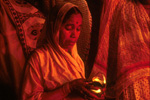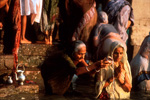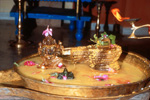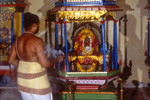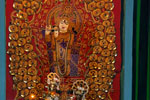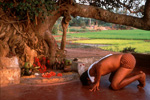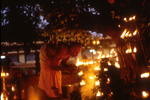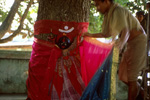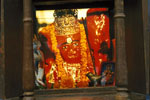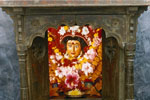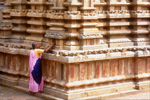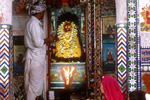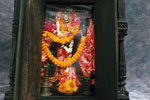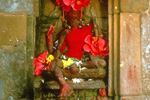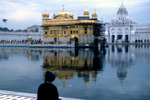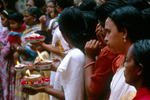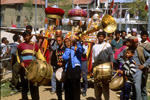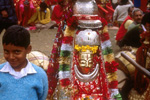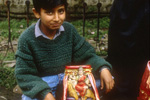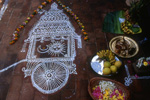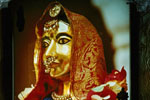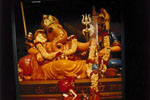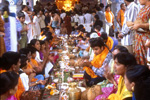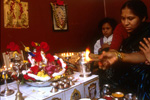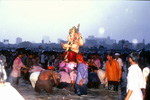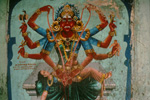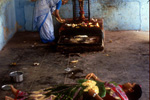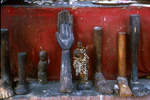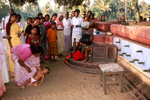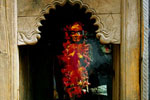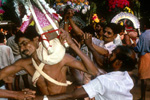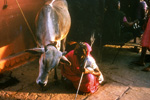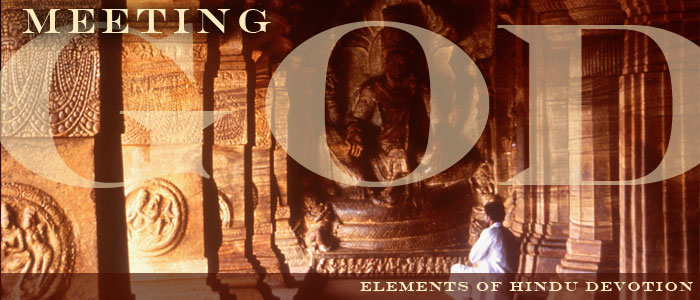
Click on a category listing to expand the content contained within that section
Click on a thumbnail to expand an image to fill your browser's window.
To save an image, either drag-and-drop the expanded image to your desktop, or click on the "DOWNLOAD" link below it.
*Some file sizes are very large and may require extra time in loading

Morning Prayers
-
Throughout India, the day begins with prayer, acknowledging the Divine in innumerable forms.
The principal aim of any puja is the feeling of personal contact with the deity. All three religions use one term to define their primary experience of the Divine: Darshan, literally translated from Sanskrit as "seeing and being seen by God", or "Meeting God". It is that moment when the entire focus of the worshiper is receptive to recognition by the God or Goddess. Darshan may be achieved in a wide variety of ways. It may be felt by an individual in his or her own daily household pujas or meditations, when the contact is made alone. A person may experience darshan simply by viewing a particularly sacred sculpture or holy spot, perhaps during a pilgrimage or at a festival. Or, the individual may feel that special communication with the deity through the intervention of a priest during a strictly regulated temple ritual. Through whatever means it comes, darshan brings both peace, contentment and blessing to devotees and through it, they believe, miracles can and do occur frequently.
Household Worship
-
Worship in the Home
The heart of every Hindu and Jain home is its shrine: the sacred space delineated for honoring and worshiping the gods. While a particularly devout Jain or Hindu may visit a temple every day, others go there only to request a specific favor of the deity or to fulfill specific vows. Temple worship requires the intervention of a priest, while in the home contact is direct between devotee and deity.
The pujas that take place in the household shrine are the foundation of all family actions and decisions. Everything begins and ends here. The size and description of this shrine is immaterial. It may be large and impressive, an entire room or a beautifully designed edifice, or it may be simply a tiny niche, or even just a row of religious prints pasted on a wall.
Every day members of the family perform personal rituals at this shrine. As in a temple, the energy of the deity is invoked to enter the image. During the puja the God, Goddess, or (in the case of Jains) Jina is believed to be present within the home, protecting the family and engendering a positive future.
The shrines in this exhibition are recreations of some of those used in different parts of India. The transparencies at the back depict sacred images presently in worship.
Open the doors yourself to experience what it might be like to visit a shrine in India.Hinduism
Hinduism is a complex and diverse religion. Literally speaking, Hindu simply means "of India", a term devised by those outside the culture attempting to understand it. Many contemporary followers of this indigenous religion of India call it Sanatana Dharma.
No emphatic statement can be made about Hinduism without exception; it truly is a religion of opposite and complementary forces that embraces an extraordinary diversity. Three primary sects harmoniously coexist in India: the worshipers of Shiva (the Creator and Destroyer of all Existence), Vishnu (the Protector or Preserver of the Universe), and Shakti (the Pervasive Feminine Principle, the Dynamic Power). Each of these deities is believed by their millions of devotees to be the ultimate, the Supreme Personified Godhead.
Most Hindus, however, also believe that the universe functions by the symbiotic coexistence of all of these powers, each of which must be acknowledged in order to maintain balance. God in an absolute state is neither male nor female, but the combination of all opposites. Consequently, Hindus who choose to focus upon a male deity know intrinsically that the feminine divine is of equal importance. Many Hindus, both male and female, regard the Goddess as their primary deity. Furthermore, many that consider themselves the disciples of Shiva, may still also worship Vishnu and Shakti; while the adherents to faith in Vishnu, may also pray to Shiva and Shakti. Their allegiance to one primary deity does not deny the importance of their recognition and honoring of the rest. The complexity of Hinduism is created because each sect has its own distinct mythology that includes a complex substrata of incarnations and/or attendant deities and the subsequent texts, rituals, and social and cultural observances.Image Worship
Many Indian sages have remarked that only the very few are able to understand the abstract essence of the Absolute, without form. Most of mankind, they state, need to approach God through personified images with rituals specific to that deity, not so much because the deity requires it, but more because of the limitations of the devotee. They believe that humans need something concrete to focus on in prayer. Both Hinduism and Jainism fulfill that need through innumerable manifestations. Although many images are exquisitely and elaborately fashioned by sculptors or painters, and, for the devout Hindu or Jain, artistic merit is important; it is secondary to spiritual content. Images are all created as receptacles for spiritual energy; each is an essential link that allows the devotee to experience direct communion with his or her Gods.
In general, Sikhs do not worship any images at all. They believe in direct contact with God through his sacred word as manifest in their scriptures: the Guru Granth Sahib. The reading and recitation of this holy book provides the devout Sikh with immediate personal communion with the Divine. This belief is not divergent from the attitudes of Hindus and Jains who also treat their sacred texts reverentially. However, in the absence of images in their temples, Sikhs literally worship the Guru Granth Sahib. For them it represents the presence of God.Dressing Images
For Hindus and Jains sacred images are personifications of the Divine and must be treated with proper respect. In many temples it is considered improper for anyone but the chosen priests to ever view the primary icons before they are appropriately prepared. In preparation for worship, they usually bathe, dress and adorn these images with jewelry and flowers. Few Westerners recognize that the manner in which Hindu sculptures are most often exhibited in museums, galleries and private collections both inside and outside India is considered by many Jains and Hindus to be disrespectful. These images may be beautiful in elemental form and design, but without their ritual apparel and adornment their display is thought to be inappropriate.
Sikhs treat their holy book, the Guru Granth Sahib, in a manner similar to the ways in which Hindus and Jains treat sacred images. In the temple during the day it is dressed in sumptuous cloth and surrounded by garlands of flowers.Sikhism
Sikhism is a relatively recent religion founded in the fifteenth century in northwestern India by Guru Nanak. Although raised a Hindu, Guru Nanak received divine revelations that he transcribed as the Guru Granth Sahib, believed by his followers to be the holy word of God. One of his aims was to bring warring factions of the Hindus and Muslims of his time into peaceful brotherhood. Guru Nanak's message lay in his recognition of the absolute sacredness of the divine name (nam) of God. Through pure and unsullied repetition of this name and meditation upon it, a devotee may achieve Divine Grace. In some ways this religion combines aspects of Hinduism and Islam. Sikhs are monotheistic: they believe in only one all-powerful God. They have rejected the caste system: for them all human beings are equal in God's sight, all have complete access to hearing his word in Sikh temples. In defense of their beliefs and their homeland, the Sikhs became militaristic by tradition and are still considered some of South Asia's finest soldiers. The devout Sikh tries to live moderately between the proud maintenance of a material existence and the conscientious attention to prayer.
Jainism
Jainism, as we know it, was brought to public attention in the sixth century B.C.E. by Mahavira, believed by his followers to be a Jina, a perfect being. According to Jain doctrine, Mahavira is only the last of twenty-four Jinas whose teachings precede him by several thousand years. Jainism is a complex belief system that views that each aspect of existence (human, animal, vegetal, and even elemental) has an eternal soul, born from one life to the next. The aim of the conscientious human is purification beyond material needs. This process can be achieved only through total non-violence (ahimsa): the refusal to harm any other living being. All devout Jains are vegetarian and refuse activities that would require them to participate in the taking of another's life. Even such a profession as farming is considered inappropriate to a Jain as it involves the constant destruction of plant life. These same restrictions have encouraged Jains to enter into marketing and business and indeed some of India's wealthiest and most powerful businessmen are Jains. In contrast, the supreme goal of the pure Jain is absolute asceticism in which the devotee gradually starves to death in total abstinence of the material world. Such purification combined with ritual preparation is believed to result in the expansion of the soul beyond the needs of reincarnation to become one with the universe.
Community
-
Comunity Shrines
Each Hindu community in the Indian subcontinent has its own gramadevata, the deity regarded as synonymous with the locality and everything within it. Every house, every street, all of the shops, the craft studios, the barns, the farms, the trees and bushes, the wells, the reservoirs and/or streams, the inhabitants (people, animals and insects), the spirits of those that have lived and died there previously, and even the activities, thoughts and emotions of everyone living there, all are part of one great spirit identified as a deity, a gramadevata. This deity is the community just as the community is the deity. They are inseparable. Most gramadevatas are feminine associated with the earth, fertility, healing, and protection. Their names often reflect their association to the Mother Goddess: they are usually prefixed or suffixed with Ma, Mata, Matrika or Amman (each a regional translation of Mother), Ben or Bai (Sister) or Rani (Queen). Sometimes their regional identities have been merged with that of a greater pan-Indian deity, such as Durga or Mari.
Although gramadevatas are indivisible from their entire communities, their worship requires that each has a focal point, a specific place or object upon which to direct attention. The shrine of a gramadevata is usually associated with an important element of nature: a hill, a boulder, a stream or pond, or a tree or grove of trees. Trees are by far the most common: there are hundreds of thousands of sacred trees in constant worship in India. Most are ancient, venerated as gramadevatas for untold centuries. The appearance of these tree sanctuaries is as varied as the communities themselves: sometimes there are several trees together, or a single tree with a large platform built around it, or one marked with flags and banners or with its trunk dressed like the Goddess herself. The Temple
-
Each Hindu, Sikh and Jain temple in India is different: its architecture, decoration, size, and contents are unique to its own history and specific purpose. Most are built upon sites that have been in worship for as long as anyone knows. In Hindu temples, the central image in many is primordial, a natural stone that has been viewed as a god or goddess for millennia. The structures around these images have grown up over centuries through the contributions of grateful devotees.
A temple's growth is entirely based upon the concept of reciprocity. In contacting God or an individual deity in puja, a devotee's desires may be implicit, without a special request, or may include prayers for something specific, such as good employment, or increased wealth, or improved health. In either case, devotees who consequently experience good luck must share their fortune in acts of kindness and also in honoring the deity to whom they have prayed. A greater fortune demands a bigger repayment. A large temple may well have begun as a shrine to a local community deity.
Many new Hindu, Jain and Sikh temples are already in active use in North America and Europe including Houston. This modern trend simply continues an historical precedent: temples have always grown through the combined influences of reciprocal donations, traditional values and fashionable technology.
Virtually all temples have grown through this process: either gradually through the donations of grateful individuals and groups, or rapidly through the sponsorship of one powerful and wealthy person. A new temple most often stands directly upon the spot that has been a focus of worship by the local community for generations. Even ub a new location special rituals are carefully enacted to cleanse and purify the new area before construction is begun. The architecture of the new building will be carefully planned so that its proportions and alignment both cater to the demands of ritual and facilitate the needs of worship.Priests
Most temples employ the services of one or more Brahman priests to conduct the rituals and act as intermediaries with the Divine. The reasons are complex: Brahman priests have been trained since childhood in the intricate proscriptions of proper ceremonies. Brahmans are taught the appropriate means of approaching the deity, the ancient detailed scriptures and rites of preparation and supplication. The image in a temple is considered to be far more powerful than that in household and many smaller community shrines. According to popular belief, it is imbued with the direct manifestation of the Divine and further enhanced by the centuries of focused worship. Brahman priests are always male, organized in large temples into complex hierarchies.
The Sanctum
The temple compound is a microcosm, a conscious replica of the conceptual universe. It functions not only as a seat of the Divine, but also as a metaphysical means of transcending the exterior worlds and entering the center, visualized as the matrix of creation. Consequently the entire temple plan is intended to assist the progression of the devotee from mundane existence to divine realization.
The inner sanctum of the Hindu temple is called the garba grha, literally translated as 'chamber of the womb'. It holds within its dark and unadorned recesses the potency of the central image, the absolute power of the God or Goddess. No one but qualified priests are allowed to enter here -- to do so might adulterate the purity of the power. Even these priests must undergo rituals of purification each time they wish to enter this 'womb'. All other devotees approach the image as close as possible for darshan with the deity. In some temples they are allowed to reach and touch the base of the image or the feet of the Divine, believing that by doing so they absorb the God's radiance through their fingertips. Non-Hindus are not permitted to enter the final stages of many of the most important temples as it is feared that by inappropriate thoughts or gestures they might desecrate the image.Hindu Tolerance
Only rarely do Hindus proselytize; most respect the rights of others to their own beliefs. According to the tenets of Hinduism, all philosophies and belief systems are considered to be equally valid paths to salvation, and it is considered inappropriate to judge the choices of others. Exceptions to this attitude are found in politically motivated disturbances, such as the Hindu-Muslim or Hindu-Sikh riots in the twentieth century. Without political exploitation, Hindus live in close harmony with those of all religions. As in most families, Hindu children grow up learning to follow the tenets and customs of their parents. But in adolescence and young adulthood, they are encouraged to make their own choices as to what primary Hindu Gods or Goddesses they find personally inspiring. Although as adults they will continue to practice many family rituals, they also conduct their own private worship in whatever manner seems most beneficial to them. In order to perform appropriate rituals correctly, they usually rely upon the advice of respected religious teachers and priests. Many do choose to continue to observe the rituals associated with the deity to whom the family has prayed for generations. It is, however, by no means unusual for a son or daughter to realize that his or her needs will be better met by focusing attention on a different deity and its corresponding rituals. In most cases they still will retain the respect and goodwill of those that continue inherited traditions.
It is remarkable that as Hindus have modernized and chosen lifestyles that embrace contemporary technologies and occupations, in general their traditional beliefs are not diminished. It is just as likely that a neuro-surgeon will be as devout as a farmer, a nuclear physicist as a craftsperson, a computer technician as a housewife. Hinduism continues to be one of the most adaptable religions in the world. Processional Images
-
Temple Festivals
Festivals provide a sense of identity and unity for each member of society regardless of family, income or position. They meld personal needs with communal awareness. The temple may be seen in a very real way as an extension of the individual. Its activities are directly related to the character and personality of the devotee. The transfer of the deity from the inner sanctum to the street, from the dark womb of the temple in the center of the city to the thronged parameters of its businesses and residences symbolizes the opening of the heart and mind of each individual through participation in this annual celebration. For a country where much of the population lives near the poverty line, these festivals enable devotees to share in the wealth and glory of their Gods. In many ways community abundance, and its consequent reflection in the wealth and grandeur of its temples and festivals, is viewed as personal abundance. It may be argued that most Hindus experience poverty differently from many in the West. For them the deities and their individual personalities are very real and approachable and the opulent celebration of the gods is a vicarious extension of the devotees themselves. The more extravagant the festival, the better it is.
Deities in Procession
Most Hindu temples, and many smaller shrines, parade the images of their deities through their surrounding communities at least once each year. It is considered auspicious for the energy of the image to bless the streets and environs and for devotees to have this special darshan, or communion, with the deity. The procession enables the elderly and infirmed, who might not be able to visit the temple, to see and be blessed by the Divine.
Most primary images in worship cannot be moved. Even if it was physically possible to carry the icon out of the womb chamber of its temple, it would be considered sacrilege to do so. For this reason, most temples have a secondary image for each of the primary deities worshipped within its precinct. This processional image, called an utsava murti, is usually cast in bronze and its form, strictly regulated according to the specifications of ancient scriptures, may be quite different from that of the primary image. Ephemeral
-
Ephemeral Shrines and Images
Each Hindu's year is punctuated by many ephemeral rituals that include shrines and even images of deities that are created only for the brief duration of worship. Deities are particularly associated with certain auspicious days when their worship is believed to bring special merit. Temporary shrines will be built either within the home or alongside the street. As the entire purpose of these structures is to honor the Gods, their production is often elaborate and very creative. Remarkably beautiful buildings may be designed and constructed, only to be torn down a few days later, and all of their elements recycled. The images may be created by the householder or they may be purchased in a market or commissioned to be sculpted by a craftsman or artist. In most cases, purchased or commissioned images will be sculpted in unfired clay as they are intended to be ritually dissolved by immersion in water when the pujas are complete.
Recycling is a concept essential to traditional Hinduism. Until only a few years ago, nothing was wasted. Paper, metal and heavy plastics were never discarded; they were reused. The only litter was sewage and sludge. A pervasive attitude suggested that the products of the earth should eventually be returned to the earth who is envisioned as a Goddess that must be honored. Contemporary mass-production of plastics and other cheap, non-biodegradable substances has distorted that ethic and today the streets of India are increasingly littered with accumulated waste. However, the basic archaic principle still affects the creation of temporary abodes for the gods. Hindus take pride in the fact that every aspect of these shrines is recycled. Vows and Healing
-
Vows
Another common means of clearing the negative karma created by past mistakes in action or judgment is through the fulfillment of a specific vow (vrata) to the Divine. A devotee promises the deity that he or she will regularly undergo a certain action that will help to purify body and mind and demonstrate piety.
Any vow, simple or complex, is a serious commitment to the Divine and must be enacted exactly as it was promised. Stories abound of dishonored vows and the Divine Retribution that followed. Although anyone may commit to a vow, most are made by women. As has been stated, feminine strength (shakti) is revered in India. Women are believed to be much stronger in character and resolution than men. They are given the responsibility to keep the karmic balance of the household. The knowledge of most of the sacred traditions of home and family are passed down through the women. Although men are often involved in household pujas, it is the women who conduct almost all of the many other rituals that take place throughout each year, including the vratas, fasts and other ascetic observances. A primary purpose of most of these is to lessen the burden of the family's bad karma, their toxicity, and thereby improve the status quo.
A vow is a personal choice that does not require the services of a priest, Brahman or otherwise. The rituals have been handed down in Hindu households from mother to daughter and from mothers-in-law to daughters-in-law for centuries. They are conducted by every class and community, and in every region, although they vary in form and demand according to the individual traditions of each family. The strictures that they require may be severe; but the fulfillment of a vow often encourages a freedom of artistic expression in music, dance, storytelling and poetry, artistry and craftsmanship.Karma
In general, healing is believed to come to those that deserve it. For Hindus, Sikhs and Jains disrespectful or inappropriate behavior (for example: the seeking of self-satisfaction at the expense of one's family or friends) is considered to demean the individual character and to create bad karma. Karma is based upon the absolute law of cause and effect, of total responsibility for one's actions. Karma is the sum of the entire character, the tally of all the good and bad acts in this life and all previous lives. Social or material inequalities are viewed, in part, as the natural product of past-life karma. Each individual is ultimately accountable for every choice, every action and even every thought. It is impossible to escape from the consequences of one's own past choices, but the future is open. Each person is the architect of his or her own future karma.
Selfless dedication to the duties in life, to the responsibilities undertaken by being born into this body, this family and this occupation, are considered to be a virtue, to create good karma. Countless treatises, legends and stories extol the virtuous life. Clear-sighted commitment to the fulfillment of duty to family and deity are the highest possible human achievement. Acts of virtue are believed to attract the positive attention and beneficence of the gods and, when necessary, to clear a path for healing energy. The purpose of many rituals is to improve the balance of karma. The properly conscientious devotee conducts regular pujas, in which the Gods are honored and extolled, as well as samskaras, in which the events of the life cycle (birth, betrothal, marriage and death, to name a few) are appropriately celebrated.Healing
One of the underlying popular tenets of all three religions is the acceptance of miracles. Most believe that direct appeal for aid from a deity often results in Divine Intervention. God, the Gods and Goddesses, and the Jinas are approachable and, when properly beseeched, will change the course of events. Prayers for intercession may be made to any deity, the choice entirely dependent upon the beliefs and inclinations of the devotee. Stories in every neighborhood revolve around ancestors and/or acquaintances whose sincere devotion resulted in the prevention of misfortune and disaster. Elements of nature such as trees or rocks are believed to possess powerful healing energy. Just the ability to touch such an object may result in a miracle. Innumerable examples exist of such healings.
A divine image, particularly one that has been under worship for years, may be considered to be so imbued with sacred energy that simply being in its proximity may heal disease and reverse misfortune. The longer it has been the object of worship, the more powerful it is believed to be.Possession
Possession by a deity is not uncommon in India. Many festivals include members of the community that regularly become possessed to dance erratically through the crowds and to speak as oracles, giving direct messages to individuals, deciding disputes and dispensing justice. However, this intensity of belief does not necessarily exemplify zealotry. A mainstream Hindu, conservative or liberal, from any walk of life (farmer or professor, princess or sweeper, rich or poor) may be possessed by a deity. A trance may occur in the middle of a puja, or while singing devotional hymns (bhajanas), or in having darshan with a deity during its procession on the street. The time and place is unpredictable. Typically, the devotee is overcome by a trance and begins to shake or roll on the ground or dance uncontrollably. He or she may mumble incoherently, or cry out the name of the deity again and again, or deliver Divine messages, often very wise, in an unaccustomed voice. The trance may last minutes, or hours or even days. When it is over, the person is often exhausted, but elated. People who are possessed usually claim great insights and deep inner peace. Those that witness this transformation feel that they are in the presence of the Divine and that their lives are enhanced by the experience.
Old Age and Renunciation
Classical Hinduism divides human life into four ideal stages. Both Sikhs and Jains observe similar approaches. The first two stages are integrally involved with society: the child and student who is still learning the fundaments of existence; and the householder who marries, works and raises a family. The second two are concerned with removal from society: the elderly person whose responsibilities towards employment and family are finished and who may spend the remaining years in pursuit of spiritual goals; and the renunciate who chooses to reject all material possessions and familial bonds to live as an ascetic and mendicant.
Many Indians remain actively employed until they are very aged. In the extended family household, the elderly are often indispensable. Close relationships between generations are still one of the foundations of society. The young, whose parents may be occupied with jobs away from the home, rely upon their aged relatives to care for them and teach them. The knowledge of traditions and spirituality, still so essential in contemporary India, is largely maintained through this generational link.
Growing old is perceived as a blessing in India. It is a time of lessened responsibilities and of extended devotion. The majority of the latter part of their lives may be spent in the reading of spiritual literature, in sacred discourse with both peers and juniors, and in meditation and prayer. These last years are a period for cleansing negative karma and preparing for death and eventual rebirth.
Also within the fabric of Hindu and Jain societies is the means for total escape from the boundaries of normal existence. Individuals that are so inclined are encouraged to step outside all convention, to live as hermits and ascetics and spend their years totally immersed in spiritual pursuits. The respected renunciation of community and property has been an integral part of Indian culture for thousands of years. The act of complete renunciation is very difficult. It means the total denial of all attachments: family, home, childhood friends, occupation and possessions. More than five million of these ascetics live in India.
